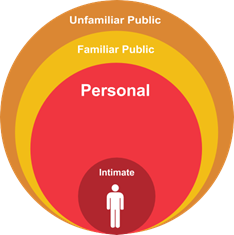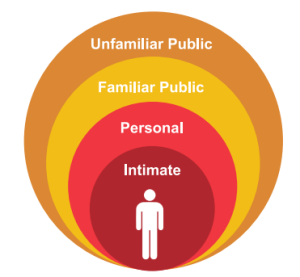33 Wrap-Up
Discussion 
At the beginning of this chapter, you placed yourself on a scale similar to the one below.
![]() Read the descriptions on the left and the right.
Read the descriptions on the left and the right.
![]() Count how many points are most true for Claire, Gilles, Ivan and Roshan.
Count how many points are most true for Claire, Gilles, Ivan and Roshan.
![]() Place
Place  (Claire),
(Claire), ![]() (Gilles),
(Gilles),  (Ivan), and
(Ivan), and  (Roshan) on the scale.
(Roshan) on the scale.
|
|

Discuss any patterns you see in how Canadians tend to express opinions.
What similarities and differences do you notice in how people from other countries tend to express opinions.
Reflection
In this chapter, we
- recognized differences between personal and public conversations
- compared how people share or filter the same information with different people in different ways
- identified social conventions around sharing, filtering, or withholding information
- looked for patterns among what people think, what they say, and what they withhold
- adjusted what words we choose and how much detail we give to be appropriate in personal or public conversations.
The writing and speaking activities gave us ways to adjust our use of English. Observing how people in our community talk and write, and trying to use new words from this chapter has reinforced, or strengthened, our vocabulary outside class.
1. Review any Language Log pages you completed during this chapter.
2. Review any rubrics you made for the Extension Activity.
- How did assessing, or reviewing, the quality of a public performance affect how you think about the rubrics used to assess, or evaluate, your writing and speaking?
- Do the rubrics record enough information to measure your language skills?
- Do the rubrics identify what you are doing well or what you need to improve?
3. At the beginning of this chapter, this set of circles illustrated boundaries for discussing certain topics. In which circle are you most comfortable receiving an opinion about your language learning?
- Are you comfortable having grades posted in public where unfamiliar strangers might see them?
- Do you prefer everyone in your class learning how everyone else is doing?
- Is a one-on-one conversation with your instructor or tutor the most comfortable?
- Would you rather read individual comments by yourself?
4. Reflect on whether the circles above, where each level widens evenly to the next, match your own boundaries.
- Are you comfortable keeping thoughts on some topics to yourself ? Are there different topics you share in personal relationships, others with the familiar public, and still others in public with unfamiliar people?
or
- Are there far more topics you feel comfortable sharing about only in personal relationships? Do you filter most of your opinions in public? Do you withhold almost all your feelings with unfamiliar people?
Do the boundaries in this second set of circles match more closely with your own?
 If you could redraw these circles to match your boundaries on topics as well as space, what would they look like?
If you could redraw these circles to match your boundaries on topics as well as space, what would they look like?


